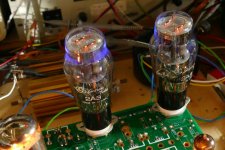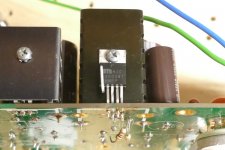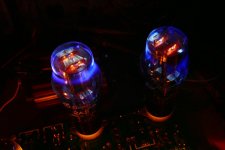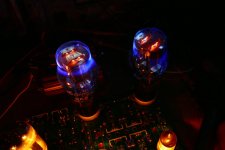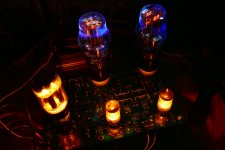I looked on Microchip.com as they now sell direct to consumer like TI does. They show the MIC29502WT as not available until next year but suggest the MIC29503WT as a possible alternative. They do not state that they are NOT directly compatible.
A couple months ago I ordered some TI regulator chips to test in the TSE-II board but have not yet tried them. I'll see if I can get that set up in the coming week or two.
If you decide to try the MIC29503WT chip test it first with NO tubes in the board. If things don't work out, you don't want to fry an expensive tube.
A couple months ago I ordered some TI regulator chips to test in the TSE-II board but have not yet tried them. I'll see if I can get that set up in the coming week or two.
If you decide to try the MIC29503WT chip test it first with NO tubes in the board. If things don't work out, you don't want to fry an expensive tube.
For now I think I will try to wait and see if the 29502 comes back in stock somewhere while I collect the other parts needed for the project. Again thanks for the help.
I ran across some mic29502bt regulators which seem to have similar specs to the mic29502wt. Any idea if they are compatible?Hi George, Thanks for the info. Hopefully mouser or digikey will get the 29502 back in stock sometime soon. Cheers, Thomas
Yeah. I saw these too. I was wondering the same thing.I ran across some mic29502bt regulators which seem to have similar specs to the mic29502wt. Any idea if they are compatible?
Both Mouser and Digikey state that the MIC29502BT is obsolete or no longer manufactured. The MIC29502BT is a Micrel part number. Several years ago Microchip bought Micrel, Atmel, Supertex and some others and assimilated those parts into the Microchip product line. For the most part nothing changed except for the style of the big "M" on the packages of the assimilated parts. The part numbers remained unchanced, IE a Supertex DN2540 or LND150 became a Microchip DN2540 or LND150. I noticed no change in the performance of the parts I used when the change happened. The 'BT part is an old Micrel part. Any 'BT parts I see on the web are Micrel branded and some are almost 10 years old. The WT is the Microchip version. For there to be a part number change, there was likely a change in the design of the part, possibly for manufacturing process compatibility. The change may or may not have resulted in a spec change, and it is possible that the part number change could have been just a housekeeping change. The Micrel and Microchip data sheets do appear to be identical, so my GUESS is that they will work, but only testing will tell. If anyone tries this, test with no output tubes in the board first.I ran across some mic29502bt regulators which seem to have similar specs to the mic29502wt. Any idea if they are compatible?
I ordered some MIC29503WT's from Mouser this morning. When they get here is entirely up to UPS. Here in rural America UPS and Fedex are a crap shoot for delivery times especially with the heavy rains we are having. I also have some TI TPS75901KC chips which on paper should work in a build for 2.5 volt filament tubes. It's 6 volt maximum input voltage may prevent it from working in a 300B amp where the raw DC input can go over 7 volts. Of course, I will find it's true limit when I get the UNSET board off the bench and the TSE-II out of its year long nap on the shelf.
Digikey lists the MIC29502WT as a substitute for the MIC29502BT so hopefully it will workBoth Mouser and Digikey state that the MIC29502BT is obsolete or no longer manufactured. The MIC29502BT is a Micrel part number. Several years ago Microchip bought Micrel, Atmel, Supertex and some others and assimilated those parts into the Microchip product line. For the most part nothing changed except for the style of the big "M" on the packages of the assimilated parts. The part numbers remained unchanced, IE a Supertex DN2540 or LND150 became a Microchip DN2540 or LND150. I noticed no change in the performance of the parts I used when the change happened. The 'BT part is an old Micrel part. Any 'BT parts I see on the web are Micrel branded and some are almost 10 years old. The WT is the Microchip version. For there to be a part number change, there was likely a change in the design of the part, possibly for manufacturing process compatibility. The change may or may not have resulted in a spec change, and it is possible that the part number change could have been just a housekeeping change. The Micrel and Microchip data sheets do appear to be identical, so my GUESS is that they will work, but only testing will tell. If anyone tries this, test with no output tubes in the board first.
I ordered some MIC29503WT's from Mouser this morning. When they get here is entirely up to UPS. Here in rural America UPS and Fedex are a crap shoot for delivery times especially with the heavy rains we are having. I also have some TI TPS75901KC chips which on paper should work in a build for 2.5 volt filament tubes. It's 6 volt maximum input voltage may prevent it from working in a 300B amp where the raw DC input can go over 7 volts. Of course, I will find it's true limit when I get the UNSET board off the bench and the TSE-II out of its year long nap on the shelf.
Apparently Big Brother knows that I did a Google search for the old Micrel MIC29502BT data sheet, so I started getting blitzed with ads and even emails trying to sell me some of the chips. One email from Ebay put two chips in front of me for sale from a vendor in the US who I have bought parts from before. I now have a pair of them on their way too, but the leads are pre-formed for a lying flat (not standing up) layout. That won't stop me from testing but it might prohibit the usual mounting / heat sinking schemes. Ebay claims a 2 to 4 day delivery time, but these are in a neighboring state. All chips will meet the TSE-II board when they arrive.
I got the Micrel MIC29502BT parts that I ordered from Ebay today. They came with formed leads that were not compatible with the PC board and two pins were cut shorter than the other three. It was however rather easy to straighten them and rebend them to fit the board and the existing heat sink. The board had 4.95 volts of filament voltage with the Microchip MIC29502WT and 4.97 volts with the Micrel MIC20502BT part. I let it play for about an hour with 300B tubes and no issues were found. My line voltage was bouncing between 126 and 128 volts at the time with a Hammond 200 series power transformer. The raw DC into the regulator with no output tubes installed was 9.4 volts which would blow the 6 volt TI parts so I may not test them.
I have not yet connected it up to a Variac or tried 2A3's on 2.5 volts. The only thing resembling a date code on these parts says 9818 which could mean the 18th week of 1998. The old Micrel data sheet that I found is dated 2012. Upon a more careful inspection it clearly spells out the difference between the BT and WT parts. The BT parts are not ROHS compliant and the WT parts are, see the table on page 3. ROHS came into existence in 2003, so these could be old parts from 1998.
The Microchip MIC29503WT parts from Mouser are scheduled to be here Friday by UPS. Our UPS guy usually gets here around 7 to 8 PM and if he is running behind, he will bypass our dirt road until Monday.
I have not yet connected it up to a Variac or tried 2A3's on 2.5 volts. The only thing resembling a date code on these parts says 9818 which could mean the 18th week of 1998. The old Micrel data sheet that I found is dated 2012. Upon a more careful inspection it clearly spells out the difference between the BT and WT parts. The BT parts are not ROHS compliant and the WT parts are, see the table on page 3. ROHS came into existence in 2003, so these could be old parts from 1998.
The Microchip MIC29503WT parts from Mouser are scheduled to be here Friday by UPS. Our UPS guy usually gets here around 7 to 8 PM and if he is running behind, he will bypass our dirt road until Monday.
Attachments
https://www.ebay.com/itm/401185618243Could I ask which Ebayer you got those BT chips from?
Once straightened, the leads will be of different length with the shortest being about 1/8 inch shorter than normal. They fit on the heat sink that was already in the board which had a slot for the screw. They might not fit if there was a single hole for the screw.
The MIC29503WT parts from Mouser are "on the delivery vehicle for delivery today." That doesn't always mean that I'll get them today. They will get tested ASAP, but tomorrow the invasion of grandkids and their friends occurs. The basement lab will remain locked until they are gone.
Last edited:
I ordered some from this ebay seller in the states and the leads are full length.
https://www.ebay.com/itm/203353947019
https://www.ebay.com/itm/203353947019
I got the MIC29503WT chips from the UPS man last night. Today is my wife's birthday and we will have a pool full of grandkids, so testing might not happen until tomorrow.
The Micrel MIC29502BT parts have been tested with 2A3 tubes. They work fine.
Many have grown accustomed to seeing a harmless blue glow ON the glass of a sweep tube or even a 6L6GC that's being run at a high plate voltage. It may even dance to the music if it's played loud enough. How many people have seen that blue glow on a DHT? These 20 year old Chinese 2A3's are eating 400 volts at 65 mA each. Yes, the glow dances to the music.
I may get to the MIC29503WT parts later tonight.
Many have grown accustomed to seeing a harmless blue glow ON the glass of a sweep tube or even a 6L6GC that's being run at a high plate voltage. It may even dance to the music if it's played loud enough. How many people have seen that blue glow on a DHT? These 20 year old Chinese 2A3's are eating 400 volts at 65 mA each. Yes, the glow dances to the music.
I may get to the MIC29503WT parts later tonight.
Attachments
The MIC29503WT parts also work fine. Pin 1 must be bent out of the way and NOT inserted in the board, or simply cut off. again PIN #1 must NOT be connected in the TSE-II board, and it must not touch anything. See the first picture.
It is now totally dark, so I got some better glowing 2A3 pictures too.
It is now totally dark, so I got some better glowing 2A3 pictures too.
Attachments
Mouse has a limited stock of IXCP10M45S in stock right now!
👍 Ordered.Mouse has a limited stock of IXCP10M45S in stock right now!
Last edited:
Does the amplifier need a pre-amplifier, or does it have enough gain to simply use a potentiometer at the input?
In case the gain is sufficient high, what is the recommended resistance for a potentiometer?
In case the gain is sufficient high, what is the recommended resistance for a potentiometer?
A typical CD or DVD player will drive it to clipping with only a pot between the CD player and the amp. My 8 year old iPad will get it to play loud but only hits clipping on music that is recorded loud and compressed to death. You can use any pot that's 50K or lower, depending on what your source can drive. Most solid state stuff will have no problem driving a 5 or 10 K pot, but I use a 50K pot out of habit from when I used to have a vacuum tube based line stage / switch box. A 100K or larger pot will cause loss of treble at mid range volume settings due to Miller capacitance in the 5842 tube.
Hey! Project owner — 845 SE and diyaudio forum participants.
I discovered this project on Tubelab.com which enchanted me for its flexibility and for the designer to be directly involved in the discussions. This is really commendable!
I chose the 845 because I believe it dissipates more watts. However, I worry a lot about audible quality and timbre issues.
Assuming I'm going to use an 845 (unless someone convinces me otherwise and I'm open to all criticism) I come here to ask for help in building an ultra linear transformer. I can do it at home. I have already renewed some conventional and toroidal transformers.
I need help with these questions:
1° What voltages are most suitable for the 845? (I would never skimp on iron dimensions or copper)
2° What are the ideal dimensions of iron? (E/I or C)? GO or GNO?
3° I would like to follow the advice of this article that says it is possible to increase the number of turns of the primary, improving the frequency range? In order not to compromise the secondary specifications, they suggest increasing the wire gauge (this would make the transformer heavy which is not a problem) the idea is that it does not saturate and has an inductance close to "perfect" I would be satisfied with 80 Henriques.
Note: I intend to section the turns and deposit them vertically (90°) from the iron, interspersing with the secondary (Pi winding).
http://education.lenardaudio.com/en/14_valve_amps_5.html

I discovered this project on Tubelab.com which enchanted me for its flexibility and for the designer to be directly involved in the discussions. This is really commendable!
I chose the 845 because I believe it dissipates more watts. However, I worry a lot about audible quality and timbre issues.
Assuming I'm going to use an 845 (unless someone convinces me otherwise and I'm open to all criticism) I come here to ask for help in building an ultra linear transformer. I can do it at home. I have already renewed some conventional and toroidal transformers.
I need help with these questions:
1° What voltages are most suitable for the 845? (I would never skimp on iron dimensions or copper)
2° What are the ideal dimensions of iron? (E/I or C)? GO or GNO?
3° I would like to follow the advice of this article that says it is possible to increase the number of turns of the primary, improving the frequency range? In order not to compromise the secondary specifications, they suggest increasing the wire gauge (this would make the transformer heavy which is not a problem) the idea is that it does not saturate and has an inductance close to "perfect" I would be satisfied with 80 Henriques.
Note: I intend to section the turns and deposit them vertically (90°) from the iron, interspersing with the secondary (Pi winding).
http://education.lenardaudio.com/en/14_valve_amps_5.html
Last edited:
Hi Silvio -
Have you ever worked with high voltage? Have you any experience winding output transformers?
I suspect there has been no response to your post because what you propose seems unrealistic and potentially dangerous.
You understand that ultra-linear only applies to tetrode or pentode tubes? The 845 is a transmitter triode.
https://en.wikipedia.org/wiki/Ultra-linear
Additionally, the 845 is a scarce, physically large and expensive tube, and usually is run at high voltages like 800 or 1000 volts or higher. https://frank.pocnet.net/sheets/049/8/845.pdf
How much experience do you have with vacuum tube projects? Working with voltages in this 1000V range safely requires special techniques and experience - not for the novice. Ok for George yes (Mr. Tubelab), me maybe not, and definitely not for someone's first project. There is a thread at the top of the DIY Audio Tube Amplifier forum about safe practices that you should read - https://www.diyaudio.com/community/...s-general-and-ultra-high-voltage.30172/latest
Maybe you should read all of the original Tubelab site, and do some more reading and research.
Have you ever worked with high voltage? Have you any experience winding output transformers?
I suspect there has been no response to your post because what you propose seems unrealistic and potentially dangerous.
You understand that ultra-linear only applies to tetrode or pentode tubes? The 845 is a transmitter triode.
https://en.wikipedia.org/wiki/Ultra-linear
Additionally, the 845 is a scarce, physically large and expensive tube, and usually is run at high voltages like 800 or 1000 volts or higher. https://frank.pocnet.net/sheets/049/8/845.pdf
How much experience do you have with vacuum tube projects? Working with voltages in this 1000V range safely requires special techniques and experience - not for the novice. Ok for George yes (Mr. Tubelab), me maybe not, and definitely not for someone's first project. There is a thread at the top of the DIY Audio Tube Amplifier forum about safe practices that you should read - https://www.diyaudio.com/community/...s-general-and-ultra-high-voltage.30172/latest
Maybe you should read all of the original Tubelab site, and do some more reading and research.
Last edited:
- Home
- More Vendors...
- Tubelab
- After a 14 year run, the TSE must DIE!
